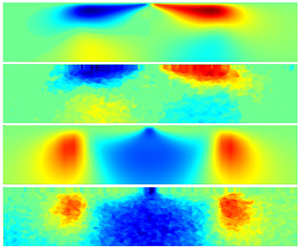Article contents
Horizontal convective flow from a line heat source located at the liquid–gas interface in presence of surface film
Published online by Cambridge University Press: 30 June 2022
Abstract

Development of the convective flow from a line heat source located at the liquid surface is studied for the case when thermocapillary convection is inhibited by the surface film. Surface film is formed by small amounts of surfactants present in non-deionized (distilled or natural) water. It imposes a no-slip boundary condition for velocity at the surface and determines the fluid dynamics of the surface layer. For the heat source located at the surface, the vertical stratification is stable and the flow is driven by a horizontal pressure gradient, formed by non-uniform heating of the liquid along the surface. Experimental studies include measurements of velocity fields using particle image velocimetry, surface relief measurements using moon-glade background oriented Schlieren and surface temperature measurements using infrared thermography. Also, numerical simulations of the flow development are performed and a new similarity solution for the steady state in a laterally unbounded domain is constructed, which takes into account the pressure gradient. The results are shown to be in good agreement with experimental data. The obtained dependencies of the maximal velocity, boundary layer thickness, local and total Nusselt numbers on the Rayleigh number are consistent with literature data obtained for the non-uniformly heated bottom case, which demonstrates universal properties of horizontal convection.
JFM classification
Information
- Type
- JFM Papers
- Information
- Copyright
- © The Author(s), 2022. Published by Cambridge University Press
References
REFERENCES
- 12
- Cited by


